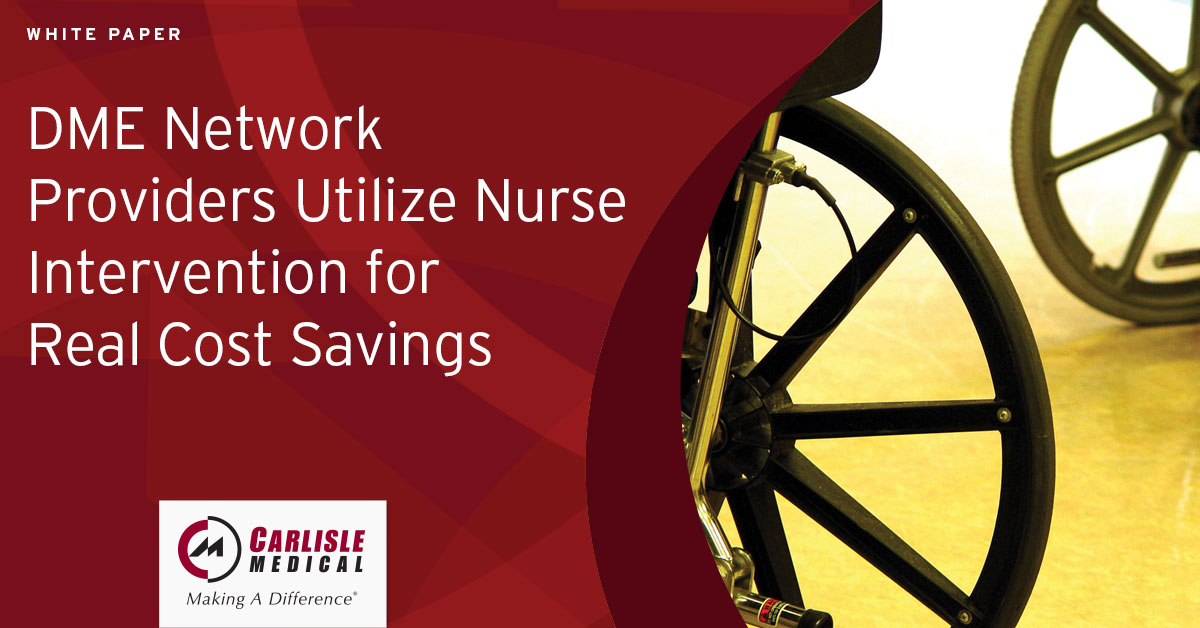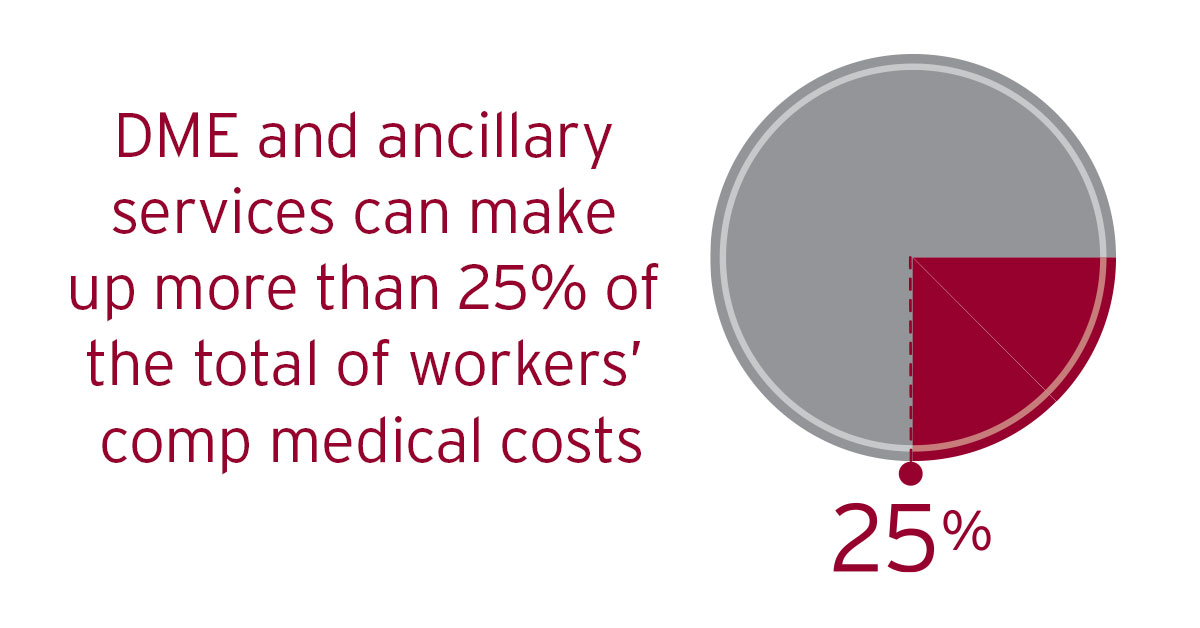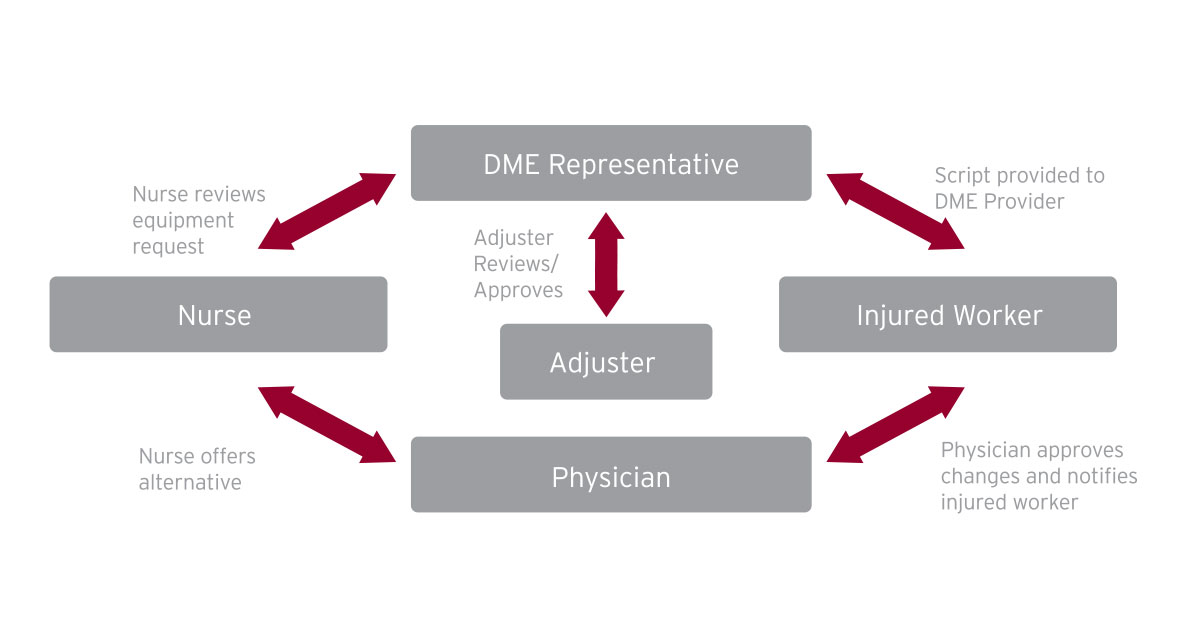DME Network Providers Utilize Nurse Intervention for Real Cost Savings


WITH RISING COSTS IN THE MEDICAL INDUSTRY AS A WHOLE, WORKERS’ COMPENSATION COSTS CONTINUE TO INCREASE, CAUSING MANY COMPANIES TO FACE AN IMPORTANT CONCERN: COST CONTAINMENT. DURABLE MEDICAL EQUIPMENT (DME) CAN HAVE A SIGNIFICANT IMPACT ON THE OVERALL COSTS ASSOCIATED WITH THE MEDICAL CARE NECESSARY FOR THE INJURED WORKER’S RECOVERY AND RETURN TO WORK.


While DME is generally a lesser expense than other expenses associated with a claim, the costs can become higher as a claim ages. Studies show DME and ancillary services make up more than 25 percent of the total workers’ compensation medical spent for the most costly older claims. [1] The amount “spent” is equivalent to the amount being paid for pharmacy-related expenses. In cases that involve DME that fall within this same amount of “spent,” risk managers should be working with their claims management team to ensure only an experienced DME network provider is managing their program. The DME network provider should have a clinical team overseeing the medical equipment and supplies being utilized. The network discounts provided can lead to realized savings; however, clinical intervention can provide significantly more savings. Clinical intervention can be presented to a physician by a DME provider or an adjuster, but the most effective method is a nurse-physician consult delivering the alternative therapy. In addition, nurses can carefully examine prescriptions and offer utilization reviews for more cost-effective alternatives.


WHAT IS DURABLE MEDICAL EQUIPMENT (DME)?
Durable Medical Equipment (DME) is defined as “any equipment that provides therapeutic benefits to a patient in need because of certain medical conditions and/or illnesses”. [2] DME items are available to be rented and/or purchased as ordered by a health care provider. There is a complexity associated with the many different types of products in each category.
DME includes, but is not limited to, wheel chairs (manual and electric), traction equipment, canes, crutches, walkers, kidney machines, ventilators, oxygen, monitors, pressure mattresses, lifts, nebulizers, etc.
DME ITEM SAMPLING:
- Crutches
- Medical Devices (i.e. tens units)
- Compression sleeves
- Orthotics/Prosthetics
- Wheelchairs


HOW ARE DME ITEMS PROVIDED?
The typical parties involved in a single DME transaction include a DME representative, the injured worker, the physician writing the prescription, the adjuster, and in some cases, a nurse is asked to consult with the physician for treatment alternatives.
Each party plays an important role in the decision making process, beginning with the physician providing the prescription for a DME item. The prescription is then sent directly to a DME network provider representative by the physician or the adjuster. This is where the expertise of the representative and the systems utilized by the DME network provider plays a vital role in reviewing each DME request for the most cost effective treatment.
IDENTIFYING NURSE INTERVENTION OPPORTUNITIES
Experienced DME representatives who work to facilitate equipment for injured workers should be trained to identify clinical review opportunities. The Official Disability Guidelines (ODG) provide valuable information about equipment costs associated with particular types of injuries. This has been a helpful resource in identifying unnecessary DME items providing the same medical benefit for $40 versus $4,200. In some cases, the requested length of treatment can be outside of the treatment guidelines and may lead to unnecessary costs; however, in other cases, the prescribed equipment may not be warranted for the injury type. DME network providers should have incorporated software systems to help identify opportunities prompting further assessment by a nurse. After DME requests are entered into a DME network provider’s system, specific reports can be generated to determine if an item is a candidate for a nurse to review. This list of items is compiled from prior DME requests that have been reviewed by nurses, and allows the nurses to make determinations on what DME requests are reviewed. This systematic approach creates an efficient procedure for monitoring all DME requests. When a potential cost savings is identified, a clinical nurse should be utilized.


NURSE INTERVENTION WITH PHYSICIAN
After utilization management opportunities are identified, equipment-supply specialists should work with staff orthopedic nurses to determine if more cost effective equipment therapies exist. In conjunction with established clinical guidelines, the Review Nurse Specialist applies his/her clinical knowledge and expertise to provide adjusters and physicians with accurate and timely prospective, concurrent, and retrospective clinical reviews for all DME items considered. The type and length of treatment, as well as the medical necessity, is evaluated during the DME Review, which is able to provide clinical recommendations for appropriate care using nationally accepted, evidence-based medical guidelines. The nurse communicates with a Clinical Management Team (including a Medical Director) to develop, discuss, and collaborate on strategic case needs. In certain situations, orthopedic surgeons may be consulted as a partner to provide an alternative recommendation. During this process, Utilization Reviews (URs) should be discussed as a secondary or more aggressive alternative. Once the review is completed, a nurse works with the claims adjuster and/or case manager to formulate an approach for alternative treatment options. These options will facilitate optimal health outcomes and a timely return to work for the injured worker.


WHAT ARE EXAMPLES OF THIS PROCESS?
Case Study 1
In a recent case, a prescription for a brand-specific thermal therapy device was submitted for review. The DME specialist recognized this type of therapy was “not the standard” and should be reviewed in more detail. The staff nurse performed a clinical review of the treatment and determined a more cost-effective treatment alternative while at the same time, provided equal medical benefit. The adjuster on the file was made aware of the nurse’s findings and agreed to the nurse telephonic consult. The nurse contacted the physician to approve an alternative device for treatment. The physician concurred with the nurse’s findings and was receptive to the alternative thermal therapy device. The alternative device offered to the claimant was a rental for $900, which resulted in 75 percent savings of $3,000 on a single DME transaction.


Case Study 2
A claimant was being treated by a doctor who prescribed a specific brand name piece of equipment. The physician prescribed the use of magnetic stimulators to aid in the claimant’s recovery at an expense of $5,470. An alternative treatment was identified by the collaborative research of the DME specialist and a staff nurse consulting with the doctor who prescribed this type of therapy. An alternative device was able to be offered for $270, providing significant savings of $5,200 on a single DME transaction.
IN CONCLUSION
DME network providers should educate staff to help identify clinical review opportunities. The DME representatives should work to recommend reviews by nurses to make recommendations on the medical necessity and cost effectiveness of equipment and supply requests. In addition, nurses should be utilized to effectively communicate alternative treatment to the physician, whether telephonically or in person. By taking the extra step of reviewing before providing equipment and supplies, companies can yield significant savings.
ADDITIONAL RESOURCES:
This white paper was prepared by Carlisle Medical in collaboration with staff Orthopedic Nurse Louise Moore, RN, CCM. Carlisle Medical has more than 35 years of experience as a leader in health care cost containment in the workers’ compensation industry. Our company assists insurance carriers, third-party administrators, and employers to significantly reduce their workers’ compensation costs. Our experienced staff of licensed pharmacists and nurses can assist companies with injuries ranging from minor to catastrophic.
REFERENCES:
[1] National Council on Compensation Insurance (NCCI), January 2013
[2] “What is DME”?, DME Library. Retreived 26 May 2016









